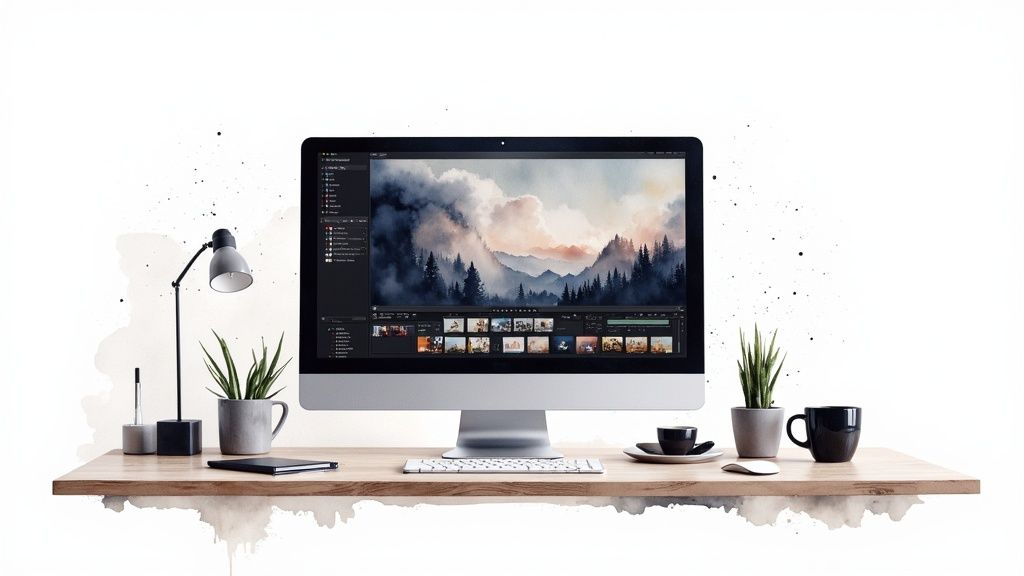Why Convert Articles To Video: The Engagement Revolution

Capturing and retaining an audience's attention is a constant challenge for content creators. In a world saturated with information, breaking through the noise and resonating with your target audience requires innovative approaches. Video offers a powerful solution. Converting articles to video represents a significant evolution in how we consume information.
The Science of Engagement
Video's effectiveness lies in its inherent appeal to our visual nature. Humans process visuals 60,000 times faster than text. Video combines visuals, sound, and movement, creating a captivating multi-sensory experience. This boosts comprehension and fosters a deeper connection with the content. The result? Improved information retention and a stronger emotional response to your message.
The Data Speaks Volumes
The impact of video content on engagement and conversions is undeniable. According to WordStream, marketers incorporating video see 34% higher conversion rates. This statistic highlights video's power to grab attention and inspire action.
Real-World Results
The influence of video extends to consumer behavior, with 64% of consumers making purchases after watching branded social videos. This demonstrates the persuasive power of video. Furthermore, Facebook video posts boast an average engagement rate of 0.26%, significantly higher than the 0.15% engagement rate for other content types. This difference underscores the value of converting written content into engaging videos.
Strategic Transformation
However, video adaptation isn't universally beneficial for all articles. Certain formats, such as how-to guides, listicles, and interviews, naturally lend themselves to dynamic visual presentations. Converting these article types to video can dramatically increase audience interaction and drive desired outcomes. By understanding these principles, content creators can strategically use video to maximize their reach and achieve their objectives.
From Words to Visuals: Your Article-to-Video Roadmap

Converting a written article into a video isn't as simple as narrating your text over a slideshow. It's a transformation, turning written words into captivating visual stories. To make sure your video resonates with viewers, you need a strategic plan. This section offers a clear, step-by-step guide to help you effectively convert articles into engaging videos.
Deconstructing Your Article: A Framework for Visual Storytelling
First, break down your article into its core components. Think of each paragraph, or each main point, as a separate scene in your video. This segmentation helps you visualize the flow of information and pinpoint places where you can add visuals. For example, a paragraph explaining a complicated idea might work well as a short animated explainer video.
This approach helps maintain a clear and logical structure, making the information easier to digest for your audience.
Matching Content with Visuals: Choosing the Right Treatment
Different types of content require different visual approaches. Data-heavy research might be best presented with charts and graphs, while a narrative-driven case study could use powerful imagery and character-focused storytelling. This thoughtful approach maximizes viewer engagement by ensuring your visuals complement the narrative.
Choosing the right visual treatment enhances understanding and makes the video more memorable.
Structuring Your Video: Maintaining Viewer Attention
A well-structured article uses headings and subheadings to guide the reader. Similarly, a successful video needs a clear structure to keep viewers engaged. Use visual cues, transitions, and on-screen text to lead viewers through the information. Also, think about using music and sound effects to enhance the emotional impact and hold attention.
These elements contribute to a more polished and professional video, making it easier for viewers to follow along.
Practical Examples: From Text to Engaging Visuals
Here are a few examples of how different article formats can be translated into video:
-
Listicle: An article like "10 Tips for Better Sleep" could become a video showing each tip with visuals, such as a peaceful bedroom or someone meditating.
-
Case Study: A written case study can be transformed into a video testimonial where the client discusses the positive impact of your product or service. A well-crafted client testimonial video can significantly build trust and credibility.
-
How-To Guide: Imagine turning a how-to article about baking a cake into a step-by-step video demonstration. This visual approach makes the process easy to follow and visually engaging.
Article Elements to Video Equivalents: A Conversion Guide
To help you visualize the conversion process, here's a table that shows how different elements of a written article can translate into their video counterparts:
To illustrate the conversion process further, consider this table outlining how different article elements translate into their video counterparts:
| Article Element | Video Equivalent | Conversion Tips |
|---|---|---|
| Introduction | Video Intro with Title and Hook | Keep it short and engaging |
| Headings/Subheadings | On-screen Text/Transitions | Use visually appealing fonts and animations |
| Body Paragraphs | Visuals, B-roll footage, Animations | Match the visuals to the content |
| Data/Statistics | Charts, Graphs, Infographics | Make data visually digestible |
| Quotes/Testimonials | Voiceovers, Soundbites, Interview Clips | Add credibility and emotional connection |
| Conclusion | Call to Action, Summary | Reinforce key takeaways and next steps |
This table provides a practical guide for transforming your written content into engaging video elements, maximizing impact and audience connection. The table highlights the key considerations for each element, ensuring a smooth transition from text to video.
By carefully considering visual elements and structure, you can create compelling videos that capture viewer attention and achieve your content goals. This roadmap provides a practical framework for maximizing the impact of your written content in a world increasingly driven by visuals.
The Creator's Toolkit: Best Tools to Convert Article to Video

Turning articles into engaging videos is a powerful way to reach a wider audience. Luckily, there are numerous tools available to help you make this conversion efficiently. From simple AI-powered solutions to full-blown professional editing suites, the right choice depends on your individual needs and budget. Let's explore some of the most popular options.
AI-Powered Video Generators
For those prioritizing speed and convenience, AI-powered video generators like InVideo and Pictory AI are excellent choices. These tools analyze your article and automatically create a video, complete with visuals, music, and even a voiceover. Simply paste your article's URL, choose a style and desired length, and let the AI do the rest. This is especially helpful for quickly transforming blog posts or news articles into video content. Keep in mind, however, that the output quality can sometimes vary.
Template-Based Video Editors
If you need more creative control while still maintaining ease of use, consider template-based video editors like Canva and Kapwing. These platforms offer a large library of pre-designed templates that you can customize with your article's text, images, and audio. This is a great middle ground between AI-generated simplicity and the complexity of professional software, often at a more affordable price. Plus, these tools are constantly updated with new templates and features, helping you keep your video content fresh.
Professional Video Editing Software
When maximum creative control is a must, professional video editing software like Adobe Premiere Pro and Final Cut Pro offer the ultimate flexibility. These programs provide a wide range of advanced editing tools and effects, allowing you to fine-tune every aspect of your video. However, these platforms require a significant time investment to master and may be overkill for simpler article-to-video conversions.
You might be interested in: Top AI Tools on Major Ad Platforms
Choosing the Right Tool for Your Needs
Selecting the ideal tool depends on balancing your resources and desired outcome. Budget, technical skills, and desired video quality all play a role. Think about what matters most. Is it speed and efficiency? Or is it having the freedom to customize every detail?
To help you compare, here's a table summarizing the key features and considerations for each category of tool:
Article-to-Video Conversion Tools Comparison
Detailed comparison of popular tools for converting articles to video content
| Tool Name | Best For | Key Features | Price Range | Output Quality |
|---|---|---|---|---|
| InVideo, Pictory AI | Speed & Simplicity | Automated video creation, AI voiceovers, music selection | Varies, often subscription-based | Can vary depending on the tool and article complexity |
| Canva, Kapwing | Balance of Ease & Control | Customizable templates, user-friendly interface | Free and paid options | Generally good, dependent on template and user customization |
| Adobe Premiere Pro, Final Cut Pro | Maximum Creative Control | Advanced editing tools, sophisticated effects | Higher cost, typically one-time purchase or subscription | Highest potential quality, limited only by user skill |
This table clearly highlights the trade-offs between different tools. AI-powered generators are quick and easy, but offer less control. Template-based editors provide a balance, while professional software demands more skill but unlocks the highest potential quality. By carefully considering your specific requirements and exploring the available options, you can find the perfect tool to transform your written content into engaging videos and captivate your audience.
Maximizing Impact: Optimizing Your Article-to-Video Content

Turning your article into a video is just the beginning. To truly unlock video's potential, you need to optimize it for maximum impact. This involves understanding the nuances of each platform, tailoring your message for viewers, and implementing technical tweaks that boost visibility and engagement. Let's explore these crucial elements of video optimization to ensure your content shines.
Platform-Specific Optimization: Tailoring Your Approach
Every platform, from YouTube to Facebook to Instagram to TikTok, has its own algorithm and audience expectations. YouTube, for instance, favors longer videos with comprehensive descriptions and targeted keywords. TikTok, on the other hand, thrives on short, engaging content with trending sounds.
This contrast highlights the importance of adapting your video's length, format, and style to the platform you’re using. This includes using relevant hashtags, actively engaging with comments, and following each platform's recommended video specifications. Consider also the viewing context. Will viewers likely have sound on? Are they watching on mobile or desktop? These considerations are vital for optimizing captions, text overlays, and pacing.
Preserving SEO Benefits: Bridging the Gap Between Text and Video
While video offers substantial engagement, don't neglect the SEO value of your original article. Incorporate keywords into your video’s title, description, and tags. A well-written description with relevant keywords helps search engines understand and rank your video content.
Transcribing your video and adding it to the description or as closed captions further improves accessibility and searchability, crucial for retaining SEO benefits. Embedding the video in your original article creates a valuable synergy. This boosts dwell time on your website, a key factor in search rankings. Video on landing pages dramatically improves conversion rates. One study showed an increase of up to 80% with video inclusion. Learn more about video’s impact on conversion rates.
Technical Optimizations: Enhancing Visibility and Engagement
Beyond content and platform, technical details significantly influence your video's performance. A captivating thumbnail can drastically improve click-through rates, acting as a visual hook. Optimizing your title and description with relevant keywords enhances discoverability.
Data-driven decisions are essential. Analyze metrics like watch time, audience retention, and click-through rates to understand audience preferences. This data informs your future video creation and optimization strategies. You might find, for example, that shorter videos perform better on certain platforms, or that specific thumbnails draw more clicks. Check out our guide on how to create video ads that convert. This data-focused approach ensures your efforts are targeted, leading to better video content and stronger engagement. By combining platform-specific strategies with technical fine-tuning and SEO best practices, you can maximize the impact of your article-to-video content and drive meaningful results.
Overcoming Real Challenges When Converting Articles to Video
Converting articles to video presents exciting opportunities, but also unique challenges. Successfully overcoming these hurdles is key to creating engaging and effective video content. This section addresses common roadblocks faced by content creators and offers practical solutions.
Maintaining Depth in Shorter Formats
One of the biggest challenges is condensing the rich information of an article into a shorter video format. Viewers have limited attention spans, so conveying your message concisely is crucial. This requires careful prioritization of information.
Identify the core message of your article and focus on communicating those key takeaways. For example, if your article explores five benefits of a product, your video might focus on the top two or three. Illustrate these benefits with compelling visuals and real-world examples.
This targeted approach ensures your video delivers value without overwhelming the viewer. Think of it as creating a highlight reel – showcasing the most impactful points in a concise and memorable way.
Visualizing Abstract Concepts
Another challenge is translating abstract concepts into engaging visuals. While articles can rely on descriptive language, videos need to show, not just tell. This requires a shift in how you present information.
Consider using metaphors, analogies, and visual representations to bring these abstract ideas to life. For example, to explain "blockchain" technology, you could use an animation of interconnected blocks, visually representing the chain of information.
This visual approach makes complex concepts more accessible and easier for viewers to grasp. It transforms abstract ideas into tangible visuals, enhancing understanding and retention.
Managing Production Timelines and Resources
Creating high-quality videos can be resource-intensive, demanding time, equipment, and expertise. Many creators face limitations in one or more of these areas. This necessitates careful planning and resource allocation.
Prioritize key scenes and consider using readily available resources, like stock footage websites such as Shutterstock and free music libraries. Additionally, tools like Pictory AI can help automate parts of the video creation process.
These tools can be a valuable starting point, especially for creators working with limited budgets and tight deadlines. They offer a way to streamline production and create engaging videos efficiently. Check out resources like this guide on creating faceless YouTube videos for more tips.
Preserving Your Voice and Expertise
Finally, adapting to video requires finding ways to maintain your unique voice and authority. This involves considering your on-screen presence, narration style, and overall video aesthetic. Think about how you can translate your written style to the visual medium.
If your article relies heavily on your personal expertise, incorporate short interview segments or voiceovers to connect with the audience directly. This allows you to maintain the personal connection of your written content while leveraging the visual power of video.
It's about finding the right balance – showcasing your personality while delivering information effectively in a visual format. By focusing on these key areas, content creators can successfully transform their articles into engaging and impactful videos.
Measuring Success: What Actually Works in Video Conversion
Converting your articles to video is a big step. But how do you know if it's actually working? It's essential to look beyond vanity metrics like view counts to understand the real impact. This section explores a data-driven way to evaluate your article-to-video strategy and identify the metrics that truly matter.
Beyond Vanity Metrics: Defining True Success
While views are a starting point, they don't tell the whole story. True success depends on your goals. Are you aiming for greater brand awareness, more website traffic, or increased conversions? Each objective needs different metrics.
For example, if your goal is brand awareness, reach and shares are key. But if you're focused on conversions, click-through rates and lead generation are more relevant. Understanding these differences is crucial for accurately measuring your video content’s effectiveness. This focused approach helps you concentrate on the metrics directly linked to your business goals.
Establishing Meaningful Benchmarks: Setting the Standard
Before measuring success, establish clear benchmarks. These should reflect your goals and industry averages. For instance, a benchmark for engagement might be a specific percentage of viewers liking, commenting, or sharing your video.
This creates a tangible goal and helps you assess your video strategy over time. Setting realistic benchmarks lets you track progress and identify areas for improvement.
A/B Testing: Comparing Article and Video Performance
A/B testing is a highly effective way to measure the impact of video conversion. This involves comparing the performance of your original article with its video version. This direct comparison helps quantify the video format's impact.
You could track conversion rates for both formats to see which drives more leads or sales. This data-driven approach provides insights into which format resonates best with your audience and contributes most to your goals. You can then refine your content strategy based on real data.
Tracking and Interpreting Results: Continuous Refinement
Setting up proper tracking is crucial for collecting relevant data. Use analytics platforms from each distribution channel to monitor metrics like watch time, audience retention, and click-through rates. Google Analytics is a powerful tool for understanding website traffic and user behavior.
This data provides valuable insights into viewer behavior and helps you understand which parts of your video are most engaging. Analyzing comments and social media mentions offers further qualitative feedback, giving you a deeper understanding of audience perception. Continuous monitoring and analysis allows you to refine your approach, optimize your video content, and maximize your ROI.
By focusing on these key principles, you can go beyond superficial metrics and truly understand what works in video conversion. This data-driven approach empowers you to make informed decisions, continuously improve your content, and achieve your business objectives. Ready to transform your content? Visit Aeon to explore our video creation platform.